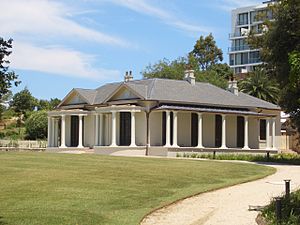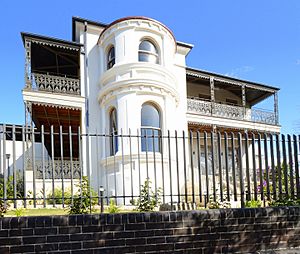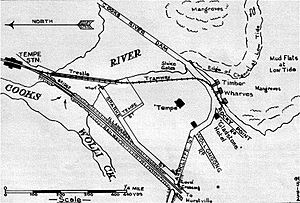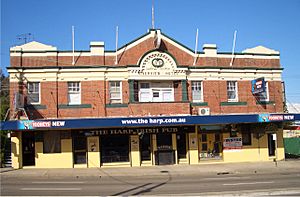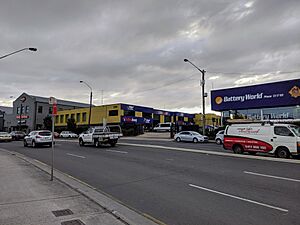Tempe, New South Wales facts for kids
Quick facts for kids TempeSydney, New South Wales |
|||||||||||||||
|---|---|---|---|---|---|---|---|---|---|---|---|---|---|---|---|

Cooks River at Tempe
|
|||||||||||||||
| Postcode(s) | 2044 | ||||||||||||||
| Elevation | 5 m (16 ft) | ||||||||||||||
| Location | 9 km (6 mi) S of Sydney CBD | ||||||||||||||
| LGA(s) | Inner West Council | ||||||||||||||
| State electorate(s) | Heffron | ||||||||||||||
| Federal Division(s) | Barton | ||||||||||||||
|
|||||||||||||||
Tempe is a suburb located in the Inner West of Sydney, New South Wales, Australia. It is about 9 kilometres south of the main city centre, known as the Sydney central business district. Tempe is part of the Inner West Council area.
The suburb sits on the northern side of the Cooks River. It is separated from Sydney Airport by the Alexandra Canal, also called Sheas Creek. Another waterway, Wolli Creek, also flows into the Cooks River nearby.
Contents
History of Tempe
Tempe got its name from a large house called Tempe House. This mansion was built on the southern banks of the Cooks River. Today, that area is known as Wolli Creek.
Tempe House and Its Builders
Alexander Brodie Spark (1792–1856) was an immigrant from Scotland. He built Tempe House in 1836. He named it after the 'Vale of Tempe', a beautiful valley in Greece. This valley was famous in ancient Greek stories.
Tempe House was designed by John Verge (1772–1861). It was built in the Georgian style. Many people consider it one of Sydney's most important historic homes. It is officially listed as a heritage site in New South Wales. From 1885 to 1985, Tempe House and its nearby buildings were used as a special home for women and girls who needed help. Alexander Spark also helped pay for land and the building of St Peter's Church of England. This church gave its name to the suburb of St Peters, which is north of Tempe.
Important Families and Places
Many streets in Tempe are named after important people from its past.
- Frederick Wright Unwin was a well-known lawyer in early Sydney. Unwins Bridge Road is named after him.
- William Bede Dalley studied with Unwin. He became one of the first members of parliament in New South Wales in 1856. Dalley Street is named after him.
- William Fanning was a successful businessman in the late 1800s. Fanning Street, in what was once Tempe Village, is named after him.
The Way family also has a street named after them, Way Street. Richard Henry Way, a lawyer, built a beautiful house called Lymerston in 1842–43. It is an Italianate villa and still stands on Hillcrest Street. Lymerston Street was originally the driveway to the house. Lymerston is one of the few large villas from the 1840s that still exist. It was a convent for nuns from 1915 to 1982. After that, it became an education centre and then a private home. It is also a heritage-listed building. There is a special window in St Peter's Church that remembers the Way family.
The Harber family was also important. Emmanuel Harber started making bricks in 1863. His son, Abel Harber, continued the brickmaking business. Emmanuel, Abel, and Elias Harber were all local councillors for St Peters. There is a memorial window for the Harber family in St Peter's Church.
The Gannon family has Gannon Street named after them. Michael Gannon came to Sydney in 1820. He later opened an inn on the Cooks River Road. Fred Gannon built his Italianate home, Hurlingham, on Union Street. It is still there and is heritage-listed. Jane Gannon was buried at St Peter's Church.
In 1963, a famous builder named Harry Triguboff bought land in Smith Street. He built eight units there. This was his very first building project. Later, he started his well-known company, Meriton Apartments.
Trams in Tempe
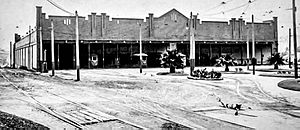
Long ago, trams were a popular way to travel in Sydney. A tram service used to run from Circular Quay all the way to Tempe. This service started as a steam tramway in 1891 and became electric in 1900. The tram line followed the Princes Highway to its end at the Cooks River.
At Tempe, there was a connection to the Tempe Depot. This depot stored many of the trams used on these lines. Because of the tram line, Tempe became a popular place for people to visit. They would come to swim and go boating on the river. The tram line closed in 1957. Today, bus route 422 follows the old tram path. When buses took over from trams, the Tempe Tram Depot became the Tempe Bus Depot. The local railway station opened in 1884 and was first called Cooks River.
Early Railway Connections
When the first part of the Illawarra Railway was being built, timber was needed for sleepers and other parts. This timber came by sea to Botany Bay. Small boats would unload the timber onto flat boats called punts. Tugs would then pull these punts along the Cooks River to Tempe Dam.
On the river bank, near the dam, the builders set up three wharves. Here, the timber was unloaded onto small railway trucks. Horses then pulled these trucks along a temporary tramway to a depot. A lot of other building materials, including steel for the railway bridge at Como, were also moved this way. They were loaded onto a small paddle steamer and taken to Como via Botany Bay.
Tempe's Old Quarries and the "Tip"
Tempe had several large clay quarries. These quarries provided clay for big brick kilns on the Princes Highway. These kilns made many of the bricks used to build Sydney.
Interestingly, fossils of a very large ancient amphibian were found in the clay pits! One of these fossils is now on display at Taronga Park Zoo.
After the clay was removed, the pits were used for landfill, which people called 'Tempe Tip'. In 1988, the tip caught fire. Today, this area has been turned into a large park with a golfing range. The name 'Tempe Tip' is now also used as a nickname for a large charity store run by the Salvation Army in Bellevue Street. But don't worry, it's not a rubbish dump!
Heritage Buildings
Tempe has several important heritage-listed sites:
- Milford Haven: This historic single-storey house, built around 1858, is located at 125 Unwins Bridge Road. It's a good example of an Australian bungalow.
- Timber Slab Cottage: Found at 44 Barden Street, this is a very old cottage made from timber slabs.
- Tempe railway station: The station itself is part of the Illawarra railway line's heritage.
- Nelson Lodge: Also known as Milford Haven, this is the same house at 125 Unwins Bridge Road.
In 2009, local residents worked to protect several other historic features. These included an old quarry cliff face, a sandstone wall from the 1880s, a historic footpath, a late 19th-century cottage, and a Californian bungalow. These were all saved from being demolished for a new housing development.
Population of Tempe
In the 2016 Census, there were 3,556 people living in Tempe. Most people (60.4%) were born in Australia. Other countries of birth included Vietnam (3.8%), North Macedonia (3.1%), and England (2.9%).
Most people (61.1%) spoke only English at home. Other languages spoken included Macedonian (5.1%), Vietnamese (4.6%), Cantonese (4.0%), and Greek (3.9%). For religion, the most common answers were No Religion (39.1%) and Catholic (19.1%).
Shopping and Businesses
Tempe's main business area is along the Princes Highway. Here you can find the Tempe Hotel, a newsagency, a doctor's office, a dentist, and a Thai restaurant. There's also a picture framing shop called "Frame Up" and Camera Warehouse.
The Riverview Hotel, which was built in 1922, is also on the Princes Highway. Nearby is Harry's Cafe de Wheels, a fast food place designed like an old 1950s drive-in.
North of the main shopping area, towards Sydenham and St Peters, there are more businesses and light industrial buildings. This area includes the largest IKEA store in the Southern Hemisphere, which opened in 2011.
Getting Around Tempe
The Princes Highway is a major road that runs through Tempe. It goes north towards the city and south towards Arncliffe and Rockdale. Unwins Bridge Road is another important road in the suburb.
Tempe railway station is on the Sydney Trains Illawarra line. This train service connects Tempe to other parts of Sydney. Transit Systems bus route 422 travels along the Princes Highway from Tempe to Railway Square in the Sydney city centre. Bus route 425 connects Tempe to Dulwich Hill.
Places of Worship
Tempe has several places of worship, including:
- St Peter and St Paul Catholic Church
- Tempe Uniting Church
- Al Hijrah Mosque at 45 Station Street
Schools in Tempe
The suburb is home to two schools:
- Tempe High School
- Tempe Public School
Sports and Fun in Tempe
- Tempe Recreational Reserve is a large park next to Cooks River. It has an indoor sports complex called the Robyn Webster Sports Centre. You can also find netball courts, football fields, cricket pitches, and a big playground for kids here.
- Col Jones Swim Centre is on Toyer Street. It has a 25-metre indoor swimming pool for lap swimmers, a sauna, spa, and steam room. There's also a gym with weights and cardio machines.
- The Concordia German Club was started in 1883. It is located in Mackay Park, Richardson Crescent. The Concordia German Choir meets here every Wednesday for practice. They perform annually at the club and other places. New members are always welcome!


